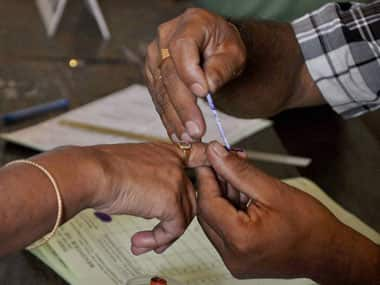If you want to see even urban parliamentary constituencies which have a strong streak of dynastic politics and a display of strength by political barons, Thane district on the edge of Mumbai may be the best example. Thane is an entirely urban constituency with Thane city, Navi Mumbai, and Mira-Bhayander in it. The son of Ganesh Naik, the former Shiv Sena warlord of Navi Mumbai who then switched to the Congress and then NCP, is seeking re-election. Sanjeev Naik’s family controls Navi Mumbai in a manner that few other politicians have been able to nationally. In another urban seat of Kalyan, Anand Parajape, the son of a former MP, the late Prakash Paranjape, is contesting on an NCP ticket. He had won the seat on a Shiv Sena ticket in 2009. His rival, Shrikant Shinde, is the son of Thane’s MLA and Shiv Sena’s district boss, Eknath Shinde. [caption id=“attachment_1495027” align=“alignleft” width=“380”]  Representational image. PTI[/caption] In Palghar, the strongest party is a local party run by a polite strongman, Hitendra Thakur. Congress, in fact, had abjectly bowed down to Thakur’s demands and withdrew its nominee, Rajendra Gavit, who is a state minister. The small party, Bahujan Vikas Party, is hoping to retain the seat mainly because it would ensure more clout in a new district, consisting almost entirely of tribals north of Ulhasnagar. The district has has been planned but not carved out yet. Palghar is a seat reserved for tribals and it is believed that carving out a new district by slicing Thane district into two would improve governance for the tribal population. That would also see districts, one urban and another not just rural, but also tribal. This is the plank that BJP’s Chintamani Vanaga is contesting on. Thakur controls the urban sprawl, Vasai-Virar by holding the reins of its civic body. This allows for a rich and visible mix of politics and construction business which has since been enlarged to cover other sectors. His son, Kshitij Thakur, is also the local MLA, just as Ganesh Naik’s second son and a nephew are MLA and mayor of Navi Mumbai. Tackling the high voter turnout Will these regional satraps see their their applecarts be upturned this time because there has been an unprecedented pre-poll day enthusiasm among voters? Last night, the help-desk outside a polling booth in a tony Thane area saw a scrum of voters wanting to secure their voter slips. When names and addresses didn’t match, the anxiety among the voters was palpable. Would they be able to vote if they came without the voter slip? By having the election machinery distribute them, not quite efficiently, the impression has been created that the slip was mandatory, when it actually is an aid to locate the name on voter lists in the polling booths. Till the previous election, local party volunteers did the work. Last night the scrum outside the designated polling booth went on almost till 8 pm, an extension of the earlier fervour to get the names on the voters’ list. I recall seeing people who missed work to get enrolled when these drives were held. Their refrain, when asked, was “We need a change” something which was heard even before Narendra Modi’s arrival on the poll scene. The air is thick with enthusiasm to perform their democratic duty and is far removed from the intense voter apathy of the past. The percentages in the past Lok Sabha polls had mimicked the Mumbai trend. Turnouts were 40.5 and 44.1 per cent for Thane in 2004 and 2009, 35.8 and 41.8 in Kalyan, 36.3 and 38.5 per cent in Bhiwandi and 47.5, and 46,5 per cent in Palgar. However, queues in the morning indicate these could be bested. It’s hard to tell whether the presence of Narendra Modi, Arvind Kejriwal, the Aam Aadmi Party, or the preceding India Against Corruption agitation in Delhi has persuaded the voters participate in greater numbers in the elections. The AAP is not so visible in three constituencies where it fielding candidates Sanjeev Sane, Jalal Ansari, and Naresh Thakur. So what makes the constituencies in Thane different? For one, Thane and Kalyan are entirely urban seats and have a larger migrant population than ever before. Bhiwandi with a large Muslim population in the powerloom business is mostly urban, and Palghar, despite having Vasai-Virar as a part of it, is a tribal seat whose residents are keen that the tribal areas be constituted a separate district. Across the constituency, except when AAP picked its cash-strapped candidates devoid of a sufficiently significant organisational structure and strength, caste and community identities have played a role in picking candidates. This is most visible in Kalyan where being a Brahmin is said to be Paranjape’s big advantage. It helps being close to the Muslim community in Bhiwandi which is why Samajwadi Party prefers to have a candidate there. The community’s strong presence in Kalwa-Mumbra Assembly segment in Kalyan also neutralises Paranjape’s strength. These caste issues normally discounted in cities, prevail in Thane and have been part of various parties’ poll calculation just like the perpetration of various dynasties.
If you want to see even urban parliamentary constituencies which have a strong streak of dynastic politics, Thane may be the best example.
Advertisement
End of Article
Written by Mahesh Vijapurkar
Mahesh Vijapurkar likes to take a worm’s eye-view of issues – that is, from the common man’s perspective. He was a journalist with The Indian Express and then The Hindu and now potters around with human development and urban issues. see more


)
)
)
)
)
)
)
)
)



